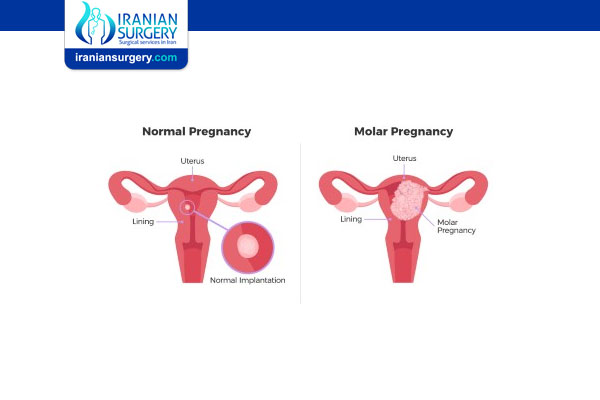Molar Pregnancy
Molar Pregnancy
What is a Molar Pregnancy?
A molar pregnancy occurs when an egg and sperm join incorrectly at fertilization and a noncancerous tumor forms instead of a healthy placenta. The tumor, or mole, cannot support a developing embryo, and the pregnancy ends. It is also called a hydatidiform mole.
Molar pregnancies are a type of gestational trophoblastic disease. In a molar pregnancy, a tumor grows in the uterus. The tumor forms as fluid-filled cysts resembling clusters of grapes.
Before Molar Pregnancy Treatment
Who is likely to have a molar pregnancy?
Although molar pregnancies are very rare, anyone can have a molar pregnancy. You are more likely to have a molar pregnancy if you:
. Are younger than age 20
. Are over age 40
. Have a history of molar pregnancies
. Have had two or more miscarriages
. Live in certain geographical locations, including the Philippines, Southeast Asia and Mexico
How common are molar pregnancies?
Less than 1% of all pregnancies – about 1 in 1,000 – are molar pregnancies.
What are the types of molar pregnancies?
Molar pregnancies fall into two categories: complete and partial.
In complete molar pregnancies, the tissue making up the placenta is abnormal, and no embryo forms. The tumor still forms and produces the pregnancy hormone HCG, which is made by healthy placentas during normal pregnancies. HCG levels are measured by many pregnancy tests.
A partial molar pregnancy occurs when an abnormal placenta forms along with an embryo. In these cases, embryos have severe birth defects. The developing tumor quickly overcomes the embryo.
What causes a molar pregnancy?
Molar pregnancies result when specific genetic errors occur during the fertilization of an egg by a sperm.
In a healthy pregnancy, a placenta forms to nourish the growing embryo. With a molar pregnancy, instead of a placenta, a tumor forms inside the uterus. A developing embryo is almost never involved in a molar pregnancy.
Occasionally, molar pregnancies develop after a miscarriage, a successful pregnancy, or an ectopic pregnancy, when cells remain in the uterus. In an ectopic pregnancy, a fertilized egg implants outside the uterus.
What are the symptoms of a molar pregnancy?
The most common symptoms of molar pregnancy include:
. Vaginal bleeding within the first three months of pregnancy
. Severe nausea and vomiting.
. Preeclampsia (extremely high blood pressure)
. High HCG levels
. Increases in abdominal size that occur much faster than in a healthy pregnancy
. No heartbeat or fetal movement
. Grape-like cysts coming out of the vagina
Diagnosis and Tests
How is a molar pregnancy diagnosed?
Your doctor diagnoses a molar pregnancy by obtaining an ultrasound of your uterus. An ultrasound uses sound waves to produce pictures of your uterus. Your doctor may also recommend blood tests to check your HCG levels.
What complications are associated with molar pregnancy?
Occasionally, parts of the molar pregnancy remain in the uterus after a spontaneous end to the pregnancy or after treatment. In these cases, persistent gestational trophoblastic disease may develop.
Persistent gestational trophoblastic disease means the initial surgery to remove the mole doesn’t cure the condition. When this happens, cells from the mole have grown into the muscle layer around the uterus. A mole that grows into the muscle layer is called an invasive mole. Invasive moles form in less than 1 in 5 women after having a complete mole removed.
In rare cases, persistent gestational trophoblastic disease causes a type of cancer called choriocarcinoma. Choriocarcinoma forms within the uterus and may spread to other parts of the body. Doctors may do a chest X-ray to determine if the mole has spread to the lungs. If choriocarcinoma has spread, it requires cancer treatments such as chemotherapy.
Other potential complications of molar pregnancy include:
. Infection of the blood (sepsis)
. Infection of the uterus
. Preeclampsia (very high blood pressure)
. Shock (very low blood pressure)
Prevention
Can molar pregnancy be prevented?
There is no way to prevent a molar pregnancy. If you have had a previous molar pregnancy, you can reduce your likelihood of complications by avoiding another pregnancy for one year after your initial molar pregnancy. Your doctor will monitor your HCG levels once a month for up to one year to help ensure no trace of the molar pregnancy remains in your uterus.
During Molar Pregnancy Treatment
Management and Treatment
How is a molar pregnancy treated?
Most molar pregnancies spontaneously end on their own. In these cases, grape-like cysts pass out of the uterus and through the vagina naturally.
Some women require treatment to remove molar pregnancies. Treatment involves dilation and curettage (use of a tool to remove tissue) with suction to remove all abnormal tissue from the uterus.
In rare cases, a hysterectomy, or surgical removal of the entire uterus, is necessary to treat a molar pregnancy.
After Molar Pregnancy Treatment
Outlook / Prognosis
What is the prognosis (outlook) for people with a molar pregnancy?
Most women who receive treatment for a molar pregnancy have no further complications.
Women can generally go on to have healthy pregnancies after a molar pregnancy. If you have a molar pregnancy, your risk for miscarriage does not increase.
When should I call my doctor?
If you are pregnant and experience bleeding from your vagina, severe nausea and vomiting, or the passage of grape-like cysts from your vagina, contact your doctor immediately. Prompt evaluation and treatment are necessary to prevent complications.
Source:
. https://my.clevelandclinic.org/health/diseases/17889-molar-pregnancy


